Discussion and Suggestions on the Planning, Design, and Construction Management of Transportation Facilities
Release time:
2022-10-28
To comprehensively promote the standardization, scientific, modernization, and refinement of urban road traffic facilities construction, it is necessary to integrate urban design, urban renewal, and urban inspections, and to summarize and reflect on past work experiences and lessons, continuously improving the construction and management level of future road traffic facilities, and enhancing the urban road traffic functions and quality through all elements.
This article takes the comprehensive improvement of urban road traffic management collaborative governance level and the continuous promotion of high-quality urban traffic development as the starting point, discussing and analyzing the strengthening of urban road traffic facilities planning, design, and construction management, and proposes relevant suggestions from five aspects: "standard procedures - renovation and upgrading - synchronous management - review and acceptance - operation and maintenance" for reference by various regions.
I. Background
In recent years, the level of urbanization in China has steadily increased year by year. According to the "2021 National Economic and Social Development Statistical Bulletin" released by the National Bureau of Statistics on February 28, 2022, the urbanization rate of the national permanent population at the end of 2021 was 64.72%, an increase of 0.83 percentage points from the end of the previous year, higher than the world average level of 55.30%, and close to the 65.20% of middle and high-income economies.
With the acceleration of the urbanization process, the urban road traffic situation in China has significantly improved, bringing great convenience to people's travel. By the end of 2020, the total length of urban roads in the country had reached 492,650 kilometers.
The rapid growth of urban road mileage has improved the traffic conditions on urban roads on one hand, but on the other hand, deficiencies in planning, design, and construction management can lead to negative issues affecting traffic safety, order, and smoothness, often attracting attention from all sectors of society.
To this end, the Central Economic Work Conference held in December 2015 deployed the promotion of supply-side structural reform, emphasizing the need to address shortcomings and improve supply quality; the national "14th Five-Year Plan" also clearly stated the need to accelerate the transformation of urban development methods, coordinate urban planning, construction, and management, implement urban renewal actions, and promote the optimization and quality improvement of urban spatial structure; the "14th Five-Year Plan" for national production safety emphasizes adhering to goal orientation, problem orientation, and result orientation, scientifically grasping the evolution of safety risks, and focusing on addressing shortcomings, plugging loopholes, and strengthening weak points.
The above deployment and planning provide direction for the current promotion of high-quality development of urban road traffic facilities from a macro perspective. This article will focus on deepening the supply-side structural reform of urban road traffic, integrating urban design, urban renewal, and urban inspections, to discuss and analyze the acceleration of the standardization, scientific, modernization, and refinement of urban road traffic facilities construction, and propose countermeasures and suggestions for full-process control from "standard procedures - renovation and upgrading - synchronous management - review and acceptance - operation and maintenance."
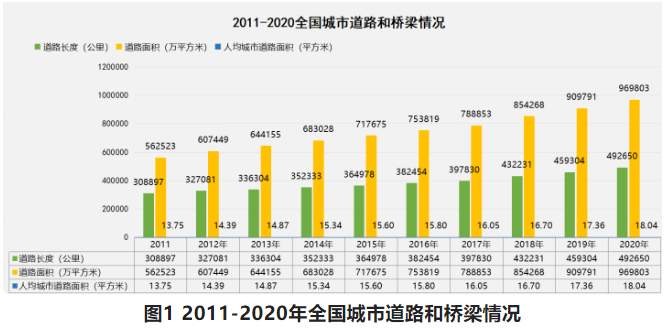
II. Overview and Current Status of Urban Road Traffic Facilities
(1) Basic Concepts of Urban Road Traffic Facilities
Urban road traffic facilities refer to various facilities set along the road to ensure the safety of vehicles and pedestrians and to fully utilize road functions, including two major categories: traffic safety facilities and intelligent traffic facilities.
Traffic safety facilities mainly refer to road supporting facilities and safety protection facilities such as traffic signs and markings, pedestrian crossings, pedestrian overpasses, pedestrian underpasses, pedestrian skywalks, pedestrian underground streets, guardrails, isolation piers, warning piles, yellow flashing warning lights, separation facilities, anti-glare screens, lighting equipment, and bus stops. Intelligent traffic facilities mainly refer to traffic signal lights, electronic police, television monitoring equipment, traffic guidance screens, parking guidance screens, speed measuring devices, traffic flow collection equipment, road security checkpoints, vehicle-road collaborative roadside units, and electronic bus stop signs, which monitor roads, guide traffic, collect flow, and facilitate communication.
The layout of urban road traffic facilities is related to the form and width of the urban road cross-section, while the road layout is related to factors such as road type, grade, design speed, traffic volume, traffic organization, overhead lines, underground pipelines, greening, and terrain.
(2) Current Issues of Urban Road Traffic Facilities
In recent years, although significant achievements have been made in the construction of urban road traffic systems in China, many problems have been identified during the system's operation. There are obvious shortcomings in traffic supply, especially the widespread phenomenon of missing and non-standard urban road traffic facilities, which on one hand affects urban traffic functions and quality as well as the overall image of the city, and on the other hand leads to frequent traffic accidents and congestion, negatively impacting urban safety and high-quality development.
To address this, relevant national ministries have successively deployed urban road traffic safety hazard investigations and urban inspections. In summary, urban road traffic facilities mainly have the following issues:
1. Unreasonable Planning and Design: Due to a lack of systematic traffic design, the traffic organization at intersections and road sections is unreasonable, the sight distance for driving safety is insufficient, the non-motorized traffic system is discontinuous, and some facilities are not set up as required. The planning and design of facilities and equipment lack comprehensive consideration, resulting in a proliferation of poles and boxes without effective integration and reuse.
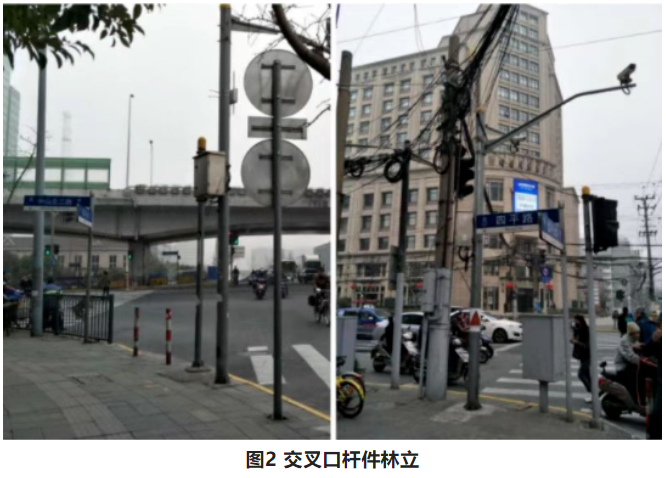
2. Non-standard Construction Management: Due to a lack of professional traffic engineering design, traffic signs and markings, traffic signal lights, electronic monitoring and speed measuring facilities, traffic isolation facilities, roadside protection facilities, etc., are set up in a non-standard or inadequate manner during construction. At the management level, there is a lack of a traffic facility operation and maintenance management system, and records of construction years, construction locations, and construction quantities are missing, leading to chaotic management of facilities and equipment.
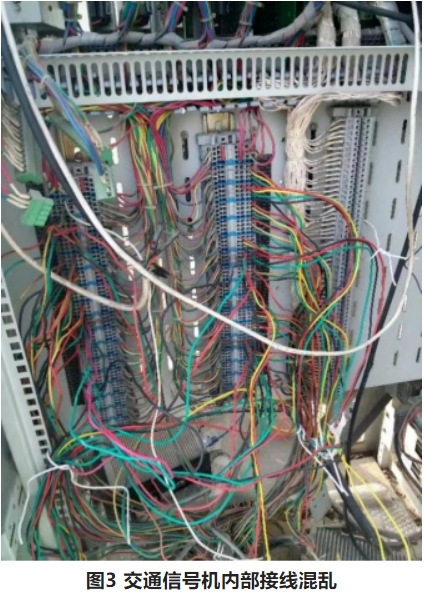
3. Inadequate Operation and Maintenance: Due to a lack of daily operation and maintenance design, the operation and maintenance of traffic facilities lack management systems, special funds, and professional maintenance teams, with a prominent issue of "heavy construction and light maintenance," and a lack of intelligent operation and maintenance management methods, which restricts the integrity and efficiency of facilities.
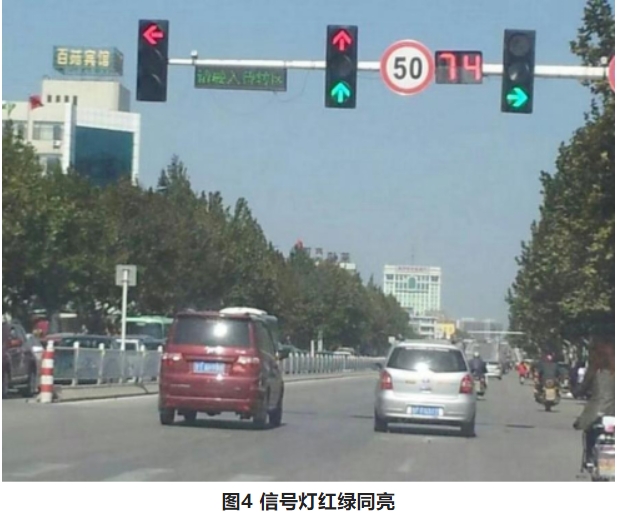
III. Discussion on the Construction and Management of Urban Road Traffic Facilities
Road traffic facilities are an important part of the urban road system, and their planning, design, construction management, and operation maintenance involve multiple departments such as planning, housing construction, transportation, and public security traffic management. It covers various aspects such as overall planning, system design, civil engineering, completion acceptance, and operation management. Therefore, it is necessary to strengthen the discussion and analysis of the current issues, urgently requiring comprehensive response and improvement measures from the perspective of multi-department collaboration.
First, strengthen the planning and design construction at the source.Further standardize the planning, design, and construction of newly built and expanded road traffic facilities to ensure high-quality supply.
Second, optimize and improve existing traffic facilities.Conduct inspections and corrections on various existing traffic facilities, system design, and timely rectification to reduce low-quality supply.
Third, strengthen the collaborative mechanism for co-construction and co-management.Standardize and improve the construction, review, acceptance, and management mechanisms of urban road traffic facilities to form a collaborative work pattern among relevant functional departments.
Fourth, strengthen the operation and maintenance management of traffic facilities.Establish a complete operation and maintenance mechanism for urban road traffic facilities, budget for annual operation and maintenance special funds, and establish a professional team to ensure normal operation and maintenance.
Specifically implement full-process control of urban road traffic facility construction from five aspects: 'standard procedures - renovation and upgrading - synchronous management - review and acceptance - operation and maintenance.'
(1) Unify the standard procedures for urban road traffic facility construction.
1. Unify construction standards.
Newly built and expanded urban roads should design, construct, and manage road traffic facilities according to relevant national standards and specifications, eliminating issues of inconsistent standards and multiple constructions that lead to non-uniform and non-standard traffic facility setups, ensuring the unity, standardization, scientificity, and precision of urban road traffic facility construction, and enhancing the functionality and quality of traffic facilities.
Planning, housing construction, transportation, public security traffic management, and other functional departments should combine local realities to study and formulate local standards and specifications for urban road traffic facilities based on national and industry standards, to standardize the design, review, construction, and management of road traffic facilities.
2. Strengthen construction procedures.
According to the overall requirements of urban road traffic management systematics, to standardize urban road traffic facility construction management, achieve optimal marginal benefits, effectively improve the construction and management level of urban traffic facilities, and ensure that urban road traffic facilities play their due positive role in addressing urban traffic issues and promoting sustainable urban traffic development.
It is recommended that urban traffic facility construction management be standardized according to the following 'four-step method': first, synchronously incorporate into road research, planning, design, demonstration, and budgeting; second, rely on the traffic design plan of the road to simultaneously design and optimize the traffic facility setup plan; third, strictly review the normative, scientific, and precise nature of the traffic facility design in the road construction drawings; fourth, introduce third-party organizations to conduct completion or concurrent inspections of system and equipment functions, forming a closed loop of construction quality control.
3. Carry out traffic design.
From the perspective of traffic facility construction management, the traffic design of the road is derived from the main design and is higher than the main design, covering traffic facility design. Newly built and expanded urban road engineering projects should add special content for traffic design.
According to the 'Urban Road Traffic Facility Design Specification' (GB50688-2011) (2019 version), 'Urban Road Traffic Organization Design Specification' (GB/T36670-2018), 'Urban Road Traffic Signs and Markings Setting Specification' (GB51038-2015), 'Road Traffic Signs and Markings Part 2: Road Traffic Signs' (GB5768.2-2022), etc., during the planning and design stage of road engineering, conduct road traffic surveys and flow predictions, traffic flow lines, and traffic organization design, simultaneously optimize the design of traffic facility setup plans, ensuring that road traffic needs are met, improving road traffic efficiency, and ensuring road traffic safety.
(2) Implement the renovation and upgrading of urban road traffic facilities.
1. Implement the renovation and upgrading of traffic facilities.
Currently, due to a lack of unified planning and management, some urban roads have various traffic facilities that form their own systems and do not connect with each other, lacking uniformity between systems.
To standardize urban road traffic facility construction management and effectively promote the enhancement of urban traffic functionality and quality, relevant management departments for traffic facilities should strictly follow the technical standards and specifications for road traffic facilities, conduct a comprehensive inspection of the road traffic facilities they are responsible for managing and maintaining, summarize the situations of non-uniform, non-standard, and non-specification traffic facility setups, timely propose rectification plans for existing problems, carry out optimization designs, and organize the implementation of renovation and upgrading projects for road traffic facilities.
2. Establish a traffic facility database.
The rapid development of urban road traffic facilities has resulted in subsequent management not keeping pace, with the lack of a complete basic ledger for urban road traffic facilities being a major influencing factor, which has become a shortcoming that restricts the effectiveness of existing traffic facilities.
Therefore, relying on modern technology to develop and use road traffic facility management systems is crucial, establishing a database for traffic facility file management and operation maintenance management, inputting various traffic facilities' design, construction, testing, acceptance, maintenance, as well as name, number, brand, model, specification, and other related information, achieving electronic and information-based full lifecycle management of traffic facility construction management and operation maintenance, and enhancing the operation and maintenance management level of traffic facilities through information and intelligent means.
3. Promote the intelligence of signal control.
Currently, many urban road traffic signal lights have issues such as inconsistent signal machine functions, incompatibility, low networking rates, and lack of traffic flow collection equipment, leading to signal lights at intersections being able to achieve only point control, unable to perform line control and regional networked control, severely affecting urban road traffic efficiency. The work of intelligent traffic signal control urgently needs to be improved. Traffic facility construction and management departments should refer to standards such as 'Road Traffic Signal Control Machine' (GB 25280-2016), 'Road Traffic Signal Light Setting and Installation Specification' (GB14886-2016) in the construction and application of traffic signal control systems, implementing intelligent transformation projects for traffic signal control, allowing traffic lights to connect to a unified control center for traffic signal control, scientifically implementing inductive signal control and multi-strategy signal control, preventing phenomena such as signal waiting and intersection overflow lock, achieving coordinated control of green waves on key roads, and regional adaptive control in key areas, accelerating the realization of networked control and intelligent control of urban traffic lights.
At the same time, by purchasing socialized services, build a city traffic signal timing center, carry out urban signal timing optimization work, fully utilize the role of the urban traffic signal control system in alleviating congestion and ensuring smooth traffic, and promote a leap in the application of urban traffic signal control technology, improving citizens' travel experience.
(3) Implement synchronous management of urban road traffic facility construction.
1. Adhere to planning first.
Newly built and expanded urban road engineering projects should incorporate traffic lights, traffic signs and markings, traffic monitoring facilities, and other road traffic facilities into road research, planning, design, demonstration, and budgeting according to national regulations, implementing the 'five synchronizations' management of road traffic facility construction, ensuring that various road traffic facilities are 'synchronously planned, designed, constructed, accepted, and put into use' according to national standards and specifications.
2. Implement funding budgeting.
Establish a funding input mechanism for road traffic facilities that is compatible with urban road construction and management, with funds included in relevant budgets and government purchases of socialized professional service directories.
First, the construction costs of traffic facilities for newly built and expanded urban roads should be included in the overall budget of the main project and guaranteed funding; second, increase investment in the maintenance, renovation, and testing costs of existing urban road traffic facilities, ensuring that various traffic facilities are maintained in a timely manner and remain operational.
3. Ensure complete facilities.
Complete and effective urban road traffic facilities are the basic guarantee for the safe, orderly, and smooth operation of urban road traffic. Urban roads should strengthen the planning, design, and construction management of road traffic facilities according to the actual needs of road traffic management, and all relevant departments should work together to ensure that various traffic facilities are complete and effective, promoting the enhancement of urban traffic functionality and quality, thereby empowering the improvement of urban traffic management levels.
(4) Strengthen the review and acceptance of urban road traffic facility construction.
1. Strengthen review and approval.
For the construction of new or expanded urban roads, the construction unit must design the road traffic facilities in accordance with national standards and specifications. During the design review phase, the construction authority should work with the public security traffic management department to jointly participate in the review of the project's feasibility study report, preliminary design scheme, and construction drawings, fully considering their opinions and suggestions, and jointly review the traffic design content. A third-party traffic consulting agency may also be hired to review the design scheme of road traffic facilities, and the final design scheme must be approved by the public security traffic management department before construction can proceed.
2. Strict completion acceptance.
The construction authority should work with the public security traffic management department to urge the construction unit to strictly conduct special acceptance of the traffic facilities for road construction according to the specifications. During acceptance, all types of traffic facilities should have a qualified report issued by a third-party institution with corresponding qualifications for the system and equipment functions, as well as a system evaluation report.
For the rectification opinions raised during the special acceptance, relevant units should organize rectification in a timely manner, and only those confirmed to meet road traffic management requirements after re-inspection can pass the special acceptance.
3. Implement accountability.
For urban road projects where various traffic facilities have not passed acceptance or have failed acceptance, they shall not be completed and put into use.
If traffic facilities are not properly set up or do not meet traffic conditions and are opened to traffic, or if rectification opinions and safety hazards raised during special acceptance are not rectified in a timely manner, leading to or causing traffic accidents, the relevant units, responsible personnel, and relevant leaders will be held accountable in accordance with the "Road Traffic Safety Law of the People's Republic of China" and other relevant legal provisions, ensuring the implementation of accountability within the legal system.
(5) Strengthen the operation and maintenance of urban road traffic facilities.
1. Handover of traffic facilities.
Urban road traffic facilities that pass acceptance are generally maintained by the construction unit during the warranty period. After the warranty period, the construction unit should handle the handover procedures to the traffic facility management department, including design drawings, completion drawings, pipeline drawings, equipment lists, technical parameters, acceptance documents, maintenance records, handover reports, and the operational road traffic facility management system. Subsequently, the traffic facility management department will be responsible for management and maintenance, with operation and maintenance funds included in the annual government municipal facility budget.
2. Operation and maintenance of traffic facilities.
Operation and maintenance are important aspects of effectively utilizing urban road traffic facilities. The phrase "30% construction and 70% management" illustrates the key role of operation and maintenance. The traffic facility management department should strengthen the daily operation and maintenance of traffic facilities based on the road traffic facility management system, enhancing the management of the entire lifecycle of traffic facilities.
Management departments should promptly repair traffic facilities that have hidden dangers, are damaged, lost, or obstructed, eliminating traffic safety hazards. For traffic facilities that are non-standard, non-compliant, or do not meet road traffic requirements, timely replacement, modification, or supplementation should be carried out to ensure the functionality of road traffic facilities is complete and effective.
4. Examples of urban road traffic facility settings.
The urban road traffic system is a complex mega-system, and urban road traffic facilities are its supporting subsystems. Below are examples of urban road traffic safety facilities and intelligent traffic facility settings, as shown in Figures 5 and 6, for reference.
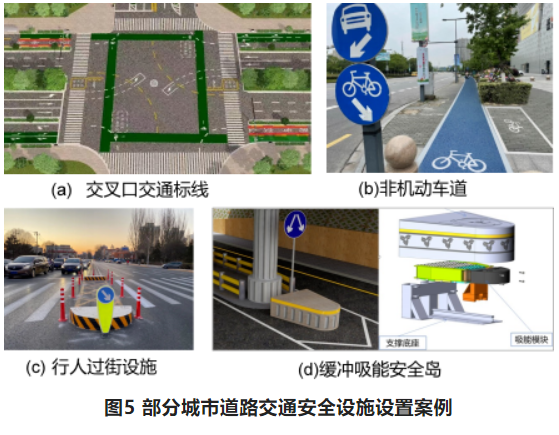
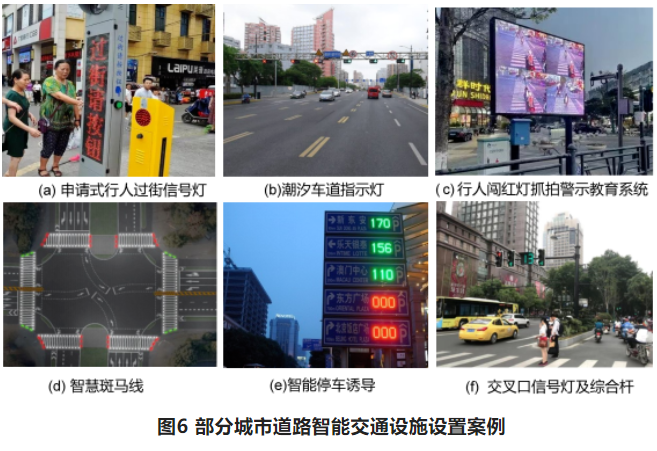
5. Conclusion
Road traffic facilities are an important component of the urban road traffic system. Strengthening the planning, design, and construction management of urban road traffic facilities is a crucial aspect of promoting the enhancement of urban traffic functions and quality. It is also an important lever for driving high-quality urban traffic development and a key indicator for assessing the achievements of civilized city creation. Therefore, the planning, design, and construction management of road traffic facilities are indispensable tasks in the urban development process, involving legal, administrative, engineering, technical, and social aspects. It is necessary to strive for optimization in macro top-level design, meso administrative systems, and micro implementation plans, and then form a synergy across legal, administrative, engineering, technical, and social levels, along with critical financial support, to achieve the best work results.
To this end, this article discusses and analyzes the standardized, scientific, modernized, and refined construction management of urban road traffic facilities. In conjunction with the ongoing urban design, urban renewal, and urban inspection work, it proposes a full-process control strategy of "standard procedures - renovation and enhancement - synchronized management - review and acceptance - operation and maintenance," emphasizing the key role of establishing and improving the five synchronization mechanisms of "synchronized planning, synchronized design, synchronized construction, synchronized acceptance, and synchronized use" for various road traffic facilities and road projects. It clarifies the need to grasp the timing and synchronization during the stages of road project initiation, planning, design, construction, and management, standardizing and improving the processes of construction, review, acceptance, management, and maintenance of urban road traffic facilities. Relevant functional departments should work together to solidly promote the standardized, scientific, modernized, and refined construction management of urban road traffic facilities, continuously improving the management level of urban road traffic facilities to ensure safe, orderly, smooth, and efficient operation.
Author: Mao Zhijian, Jiangxi Provincial Public Security Bureau Traffic Management Bureau; Wang Tao, Lu Yining, Shanghai Jiao Tong University
References
[1] National Bureau of Statistics. 2021 National Economic and Social Development Statistical Bulletin. Beijing. 2022.2.28
[2] Ministry of Housing and Urban-Rural Development. 2020 Urban and Rural Construction Statistical Yearbook. Beijing. 2021.10.11
[3] Central Committee of the Communist Party of China, State Council. The 14th Five-Year Plan for National Economic and Social Development and the Outline of Long-term Goals for 2035. Beijing. 2021.3.12.
[4] State Council Safety Production Committee. "14th Five-Year Plan" National Safety Production Plan. Beijing. 2022.4.6.
[5] Mao Zhijian, Bao Lixia, Jiang Guangsheng. Reflections and Re-recognition of Urban Intelligent Traffic System Construction. Road Traffic Science and Technology. 2016.3.
[6] National Standard. Urban Road Traffic Organization Design Specifications. Beijing. 2018.10.10.
[7] National Standard. Urban Road Traffic Signs and Markings Setting Specifications. Beijing. 2015.4.8.
[8] Ministry of Public Security Traffic Management Bureau. Guidelines for Further Strengthening the Application of Urban Road Traffic Signal Control. Beijing. 2020.10.23.
2022-06-14
Source:Saiwen Traffic Network
Related News


